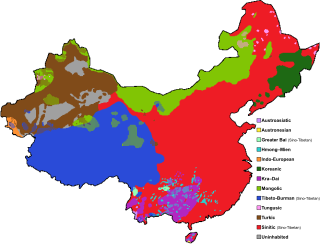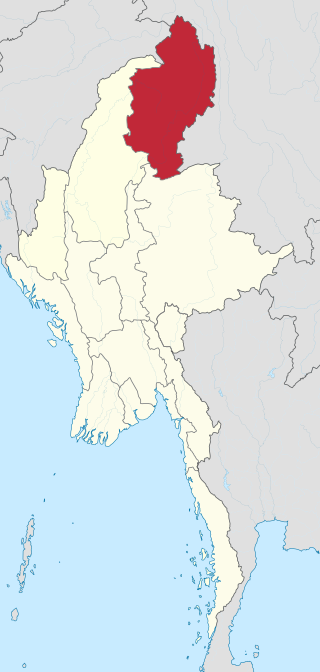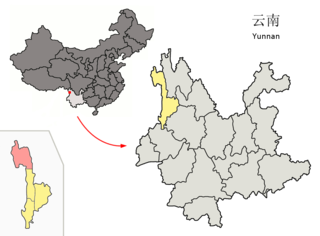Related Research Articles

There are several hundred languages in China. The predominant language is Standard Chinese, which is based on Beijingese, but there are hundreds of related Chinese languages, collectively known as Hanyu, that are spoken by 92% of the population. The Chinese languages are typically divided into seven major language groups, and their study is a distinct academic discipline. They differ as much from each other morphologically and phonetically as do English, German and Danish, but meanwhile share the same writing system (Hanzi) and are mutually intelligible in written form. There are in addition approximately 300 minority languages spoken by the remaining 8% of the population of China. The ones with greatest state support are Mongolian, Tibetan, Uyghur and Zhuang.
The Lisu people are a Tibeto-Burman ethnic group who inhabit mountainous regions of Myanmar (Burma), southwest China, Thailand, and the Indian state of Arunachal Pradesh.

The Derung people are an ethnic group. They form one of the 56 ethnic groups officially recognized by China. Their population of 6,000 is found in the Nujiang Lisu Autonomous Prefecture of Yunnan in the Derung Valley of Gongshan Derung and Nu Autonomous County. Another 600 can be found east of the Derung Valley, living in the mountains above the Nu River near the village of Binzhongluo in northern Gongshan Derung and Nu Autonomous County.

Kachin State is the northernmost state of Myanmar. It is bordered by China to the north and east, Shan State to the south, and Sagaing Region and India to the west. It lies between north latitude 23° 27' and 28° 25' longitude 96° 0' and 98° 44'. The area of Kachin State is 89,041 km2 (34,379 sq mi). The capital of the state is Myitkyina. Other important towns include Bhamo, Mohnyin and Putao.
Lisu is a tonal Tibeto-Burman language spoken in Yunnan, Northern Burma (Myanmar) and Thailand and a small part of India. Along with Lipo, it is one of two languages of the Lisu people. Lisu has many dialects that originate from the country in which they live. Hua Lisu, Pai Lisu and Lu Shi Lisu dialects are spoken in China. Although they are mutually intelligible, some have many more loan words from other languages than others.
Lipo may refer to:
The Lao Song are an ethnic group of Thailand. The Lao Song are also known as the Tai Song (ไทโซ่ง), Lao Song Dam (ลาวทรงดำ), or simply as the Song or Song Dam.

Singpho is a dialect of the Jingpho language spoken by the Singpho people of Arunachal Pradesh and Assam, India. It is spoken by at least 3,000 people. "Singpho" is the local pronunciation of "Jingpho," and the dialect shares 50% lexical similarity with Jingpho.

Gongshan Derung and Nu Autonomous County is an autonomous county located in Nujiang Lisu Autonomous Prefecture, in the northwest of Yunnan province, China. It has an area of 4,506 km2 (1,740 sq mi) and a population of about 37,894 according to the 2010 Census. The county government is stationed in Cikai Town

The Kucong are an ethnic group in China. They are considered one of the poorest minorities in the country. There are around 80,000 Kucong people, living primarily in the Mojiang, Xinping, and Mengla counties of China's Yunnan Province. Some live in Thailand, Myanmar, Vietnam, Laos, and the United States, where at least 600 are living as migrants.
George Edgar ‘Eddie’ Metcalf, Chinese name 王懷仁 Wáng Huáirén, was a British Protestant missionary serving in China with the China Inland Mission and credited with the first translation of the New Testament for the Eastern Lisu/Lipo minority.
Lolopo is a Loloish language spoken by half a million Yi people of China. Chinese speakers call it Central Yi, as the name Lolopo does not exist in Chinese. It is one of the six Yi languages recognized by the government of China.
The Lipo language, also known as eastern Lisu, is a language of the Lisu people of China, similar to but not intelligible with the Lisu language proper. Some Lipo are classified by the government as Lisu, others as Yi. In some areas, the people prefer the name Lolopo.
Lhao Vo, also known as Maru (မရူ) and Langsu, is a Burmish language spoken in Burma and by a few thousand speakers in China.
The Lisoish languages are a branch of the Loloish languages proposed by Ziwo Lama (2012) that includes Lisu and several of the Yi languages. David Bradley (1997) considers Lisoish languages to be part of the Central Loloish branch.
Micha, or Miqie, is a Loloish language of Yunnan. Its usage is declining.
The Bible has been translated into many of the languages of China besides Chinese. These include major minority languages with their own literary history, including Korean, Mongolian, Tibetan, Kazakh, Kyrgyz, Russian and Uyghur. The other languages of China are mainly tribal languages, mainly spoken in Yunnan in Southwest China.
Lamu is a highly endangered Loloish language of northeastern Binchuan County, Yunnan. According to Bradley (2007), the Lamo language is similar to Lisu and Lipo, although the speakers are classified by the Chinese government as ethnic Lahu. There are only about 100 speakers left, all of whom are also first-language speakers of Lipo. Lamo speakers were located by Bradley in 1999.
Lawu is a highly endangered unclassified Loloish language of Yunnan, China. It has about 50 elderly speakers in Jiuha village 旧哈村, Shuitang district 水塘镇, Xinping County, Yuxi Prefecture, Yunnan Province. There are possibly also some speakers in Jiujia District 九甲乡, Zhenyuan County, Pu'er Prefecture, Yunnan Province. Lawu speakers are currently classified by the Chinese government as Lahu, but were formerly classified as Yi.
References
- ↑ Hattaway, Paul, "Lipo, Eastern" (PDF), Operation China